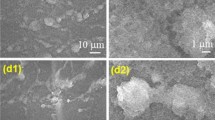Abstract
We microstructured silicon surfaces with femtosecond laser irradiation in the presence of SF6. These surfaces display strong absorption of infrared radiation at energies below the band gap of crystalline silicon. We report the dependence of this below-band gap absorption on microstructuring conditions (laser fluence, number of laser pulses, and background pressure of SF6) along with structural and chemical characterization of the material. Significant amounts of sulfur are incorporated into the silicon over a wide range of microstructuring conditions; the sulfur is embedded in a disordered nanocrystalline layer less than 1 μm thick that covers the microstructures. The most likely mechanism for the below-band gap absorption is the formation of a band of sulfur impurity states overlapping the silicon band edge, reducing the band gap from 1.1 eV to approximately 0.4 eV.
Similar content being viewed by others
References
T.-H. Her, R.J. Finlay, C. Wu, S. Deliwala, E. Mazur: Appl. Phys. Lett. 73, 1673 (1998)
C. Wu, C.H. Crouch, L. Zhao, J.E. Carey, R. Younkin, J.A. Levinson, E. Mazur, R.M. Farrell, P. Gothoskar, A. Karger: Appl. Phys. Lett. 78, 1850 (2001)
M. Sheehy, L. Winston, J.E. Carey, E. Mazur, C.M. Friend: unpublished results
A.J. Pedraza, J.D. Fowlkes, D.H. Lowndes: Appl. Phys. Lett. 74, 2322 (1999)
C.H. Crouch, J.E. Carey, J.M. Warrender, M.J. Aziz, E. Mazur: Appl. Phys. Lett. 84, 1850 (2004)
R. Younkin. J.E. Carey, E. Mazur, J.A. Levinson, C.M. Friend: J. Appl. Phys. 93, 2626 (2003)
J.E. Carey, C.H. Crouch, M. Shen, M.A. Sheehy, E. Mazur: unpublished results
The laser beam has a Gaussian spatial profile; the fluence reported here is the average fluence determined over the entire laser spot, and the peak fluence (in the center of the spot) is twice the average fluence
The average number of laser pulses used to structure a sample is defined as 〈N〉=df/s, where d= the FWHM of the Gaussian beam profile, f= the frequency of the laser pulse train, and s= the scan speed. The natural frequency of the laser pulse train is 1 kHz, but we can reduce the frequency to 150 Hz or less using a fast mechanical shutter
Z.R. Zanatta, I. Chambouleyron: Phys. Rev. B 53, 3833 (1996)
www.genplot.com
The RBS spectra may be affected slightly by the changing morphology of the surface, as the surface area of the samples changes as processing conditions change. However, the microstructures made with 2, 3, and 5 laser pulses are similar in size and shape, as are the microstructures made with 3, 4, and 5 kJ/m2, so the sulfur concentrations for those samples can be confidently compared. As the shape of the microstructures is unchanged by annealing, the concentrations before and after annealing can also be compared with confidence
E. Janzen, R. Stedman, G. Grossmann, H.G. Grimmeiss: Phys. Rev. B 29, 1907 (1984)
W. Fahrner, A. Goetzberger: Appl. Phys. Lett. 21, 329 (1972)
J.I. Pankove: Optical Processes In Semiconductors (New York: Dover Publications, Inc. 1971) p. 9
The diffusion length of S in c-Si in 30 minutes at 775 K was estimated to be 25 nm by extrapolation from data In: S.M. Sze: Physics of Semiconductor Devices, 2nd ed. (New York: Wiley & Sons 1981) p. 68, In microcrystalline or amorphous silicon, the diffusion length may be somewhat different but is unlikely to increase more than threefold
Annealing temperatures that completely eliminate the below-band gap absorptance are much lower than the temperatures at which significant grain growth would be expected in microcrystalline or polycrystalline silicon. See S. Roorda, S. Saito, W.C. Sinke: Mat. Res. Soc. Symp. Proc. 100, 417 (1988)
R. Wilson: J. Appl. Phys. 53, 3490 (1984)
P. Keblinski, S.R. Phillpot, D. Wolf, H. Gleiter: Phys. Lett. A 226, 205 (1997)
F.A. Trumbore: Bell System Tech. J. 39, 205 (1960)
V.I. Emel’yanov, D.V. Babak: Appl. Phys. A 74, 797 (2002)
D. von der Linde, K. Sokolowski-Tinten, J. Bialkowski: Appl. Surf. Sci. 109/110, 1 (1997)
P.G. Carey, T.W. Sigmon: Appl. Surf. Sci. 43, 325 (1989)
R. Reitano, P.M. Smith, M.J. Aziz: J. Appl. Phys. 76, 1518 (1994)
Author information
Authors and Affiliations
Corresponding author
Additional information
PACS
78.68.+m; 81.15.Fg; 81.40.Tv; 81.65.Cf; 85.60.Gz
Rights and permissions
About this article
Cite this article
Crouch, C., Carey, J., Shen, M. et al. Infrared absorption by sulfur-doped silicon formed by femtosecond laser irradiation. Appl Phys A 79, 1635–1641 (2004). https://doi.org/10.1007/s00339-004-2676-0
Received:
Accepted:
Published:
Issue Date:
DOI: https://doi.org/10.1007/s00339-004-2676-0




